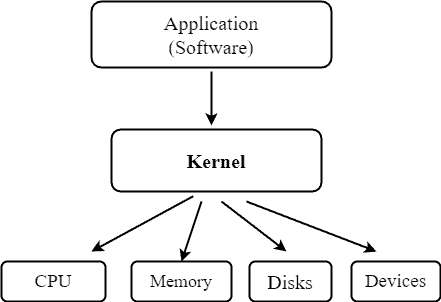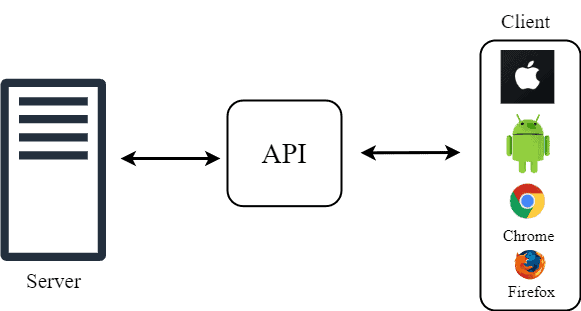1. Introduction
In this tutorial, we’ll talk about the differences between kernels, APIs, and shells.
2. Kernel, API, and Shell
2.1. Kernel
In computer science, the kernel is an intermediary between software and hardware. It assigns tasks, controls resources, and provides essential services to applications. The kernel manages tasks such as file system administration, memory management, and hardware device management:

2.2. API
An Application Programming Interface (API) is a set of rules and procedures that define how a piece of software or a code module can be used. It defines the protocols and data formats applications can employ for inter-program communication:

2.3. Shell
A shell is either a command-line interface (CLI) or a text-based user interface for interacting with an operating system or software. Users can enter text commands to perform tasks, execute programs, and interact with the computer’s operating system.
Shells utilize text-based input and output, allowing for high scriptability and the automation of repetitive tasks through scripts or batch files. Shells interact with both the kernel and applications.
In the early days of Unix, shells were the sole means for users to communicate with their computers. However, contemporary users typically favor graphical user interfaces, or GUIs, over other types of shells.
3. Differences Between Kernel, API, and Shell
3.1. Functionality
The kernel manages system resources, handles hardware interactions, and provides essential services such as process management and memory allocation.
The shell interprets user commands, launches processes, manages I/O, and serves as an interface for user interactions with the operating system.
APIs define functions, data structures, and protocols that applications can use to access and interact with various software components, services, or libraries.
3.2. Location
The kernel operates in privileged mode at the lowest level of the operating system, directly interacting with hardware.
The shell functions as a user-level program running on top of the kernel as an interface between users and the operating system.
APIs are present at various software levels, encompassing operating system APIs, libraries, and application-specific APIs. They are implemented in software code, allowing developers to access functionality or data from other software components.
3.3. Security
The kernel enforces security policies and access controls to safeguard system resources and data, managing user privileges for a secure environment.
While not directly enforcing security policies, the shell depends on the kernel for security and executes commands that interact with it to access or modify system resources.
The security of an API is essential to protect sensitive data, prevent unauthorized access, and safeguard against cyber threats. It’s the responsibility of those designing and implementing an API to ensure it’s secure.
3.4. Interaction
The kernel communicates with hardware devices, responds to applications’ system calls, and manages system resources without direct user interaction.
The shell interacts with users and applications by taking user input, interpreting commands, and forwarding them to the kernel for execution.
APIs facilitate interaction between software components, enabling one program to request services or data from another without understanding its internal workings.
3.5. Users
Users typically do not directly interact with the kernel. It operates in the background and is primarily managed by system administrators and developers.
The shell is the primary interface for end users to interact with the operating system.
Developers primarily use APIs to enable communication between different software components, and end users do not directly interact with them.
4. Examples
Operating system kernels encompass the Linux kernel, the Windows NT kernel, and the macOS XNU kernel.
Several types of shells exist, each possessing unique features and syntax. Common shells include:
- Bash Shell: A popular shell on Unix-like systems, including Linux
- PowerShell: Microsoft’s shell for Windows, designed for automation and system administration
- Zsh: An extended shell with features for customization and enhanced interactive use
- Command Prompt (CMD): The traditional Windows command-line shell
- Bourne Shell, C Shell, Korn Shell: Other Unix-like shells with unique features
APIs are present in various software components, including the Win32 API for Windows applications, POSIX API for Unix-like systems, and web APIs such as the Twitter API or Google Maps API.
5. Summary
Let’s summarize the main differences:
Kernel
Shell
API
Definition
A program that controls every aspect of the system and serves as the computer’s core.
A computer program that acts as an interface for utilizing the operating system’s features.
It is used to define communication rules among distinct software programs.
Functionality
The central part of the system that controls all of its operations.
Interface between the user application and the kernel
Facilitates the sharing of data between different applications, devices, and systems.
Abstraction Level
A low-level program.
A command line interface.
An API isn’t a program; it’s a set of rules.
All three concepts play their specialized roles in orchestrating software and hardware interactions.
6. Conclusion
In this article, we discussed the difference between kernels, shells, and APIs. The shell acts as a text-based user interface, enabling interaction with an operating system or software. Simultaneously, the kernel operates as the core of an operating system and facilitates communication with hardware. API is a set of rules and procedures defining how a piece of software is used and how other programs interact with it.